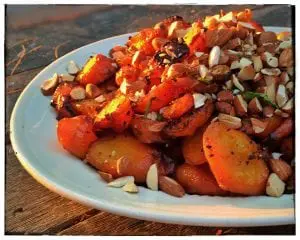By Joe Dizney
There’s one thing you can count on as Thanksgiving rolls around: variations on a theme.
Let’s see, how does that song go?
Oh yeah — roast turkey in a major key with a minor groaning-board chorus of side dishes: a mash-up of potatoes (white or sweet); purées of the latest exotic fruit and/or vegetable du jour; Brussels sprouts (or an acceptable cruciferous substitute); maybe cornbread or a bread dressing; a crisp, healthy salad (with or without pears).
Anyone for a green-bean casserole? Cranberry sauce, of course — unless you prefer chutney.
For all but the strictest traditionalist, fashion suggests the grace notes: Ethnic spices or ingredients, exotic combinations or non-traditional techniques. This is not a bad thing per se — variety is still the spice of food and life.
This recipe for charred carrots from Joshua McFadden’s excellent Six Seasons: A New Way with Vegetables was too appealing not to give it a shot. Roasting promised to concentrate the carrots’ natural sweetness and offer a slight char and its complex, appealing bitterness. Brightened with a splash of white wine vinegar and offset by a second blistering oven glaze (just the barest drizzle of honey and a spicy hit of black pepper), it’s a more sophisticated take on the traditional, candy-like Vichy carrots.

McFadden’s recipe calls for roasting whole, peeled carrots, which also promised a lingering crunch beneath the char. But I wasn’t satisfied with his results. A stovetop pan-char, which is easier to control and monitor, seems a better solution.
As simple as it may sound to slice roasted carrots into bite-sized pieces and macerate them in vinegar for a few minutes, the flavor dividends are amazing. A second hot roast in the oven candies the honey, and a final garnish of toasted, chopped almonds is another unexpected accent. The final generous grinding of cracked black pepper is a spicy counterpoint.
Further embellishment — a sprinkling of fresh herbs — adds a vegetal note. Thyme or mint are suggested, but parsley, dill and cilantro happen to be in the same botanical family as carrots and seem like natural pairings. (Little-known fact: carrots were originally cultivated for their tops; a sprinkle of carrot greens would not be out of place.)
Another variation worthy of trial is substituting brown butter for the final toss, which would add a nutty note. Maple syrup or sorghum (if you can find it) would be interesting substitutions for the honey.
Charred Carrots with Honey, Black Pepper and Almonds
Adapted from Joshua McFadden; serves 4
1½ pounds small-to-medium carrots, trimmed and peeled and left whole
Extra-virgin olive oil
2 tablespoons white wine vinegar
4 tablespoons melted, unsalted butter
Black pepper; best quality, freshly ground (medium-to-large grind)
2 tablespoons honey
Finishing salt (Himalayan pink or Maldon flakes)
½ cup almonds, toasted and chopped
Optional: 1 tablespoon freshly chopped herbs (carrot tops, thyme, tarragon, mint, dill, cilantro or parsley)
Preheat oven to 475 degrees. On a small baking sheet, roast whole almonds until fragrant, about 5 to 6 minutes. Cool on a plate, chop roughly and reserve.
Heat a large heavy frying pan on high for 3 to 4 minutes. While the pan is heating, rub carrots with olive oil to coat. When the pan is hot, add carrots in a single layer. Continually shake the pan while cooking 8 to 10 minutes until the carrots are blistered and charred in spots, but not excessively so.
When carrots are cool enough to handle, cut them into ½-to-¾-inch angled slices; transfer to a bowl and toss with the vinegar and a healthy grind of black pepper. Let sit for 5 minutes to absorb the vinegar; toss with melted butter. Spread sliced carrots in a single layer on a large rimmed baking sheet (covered with foil for easy cleanup). Drizzle with the honey and roast in hot oven for 7 to 10 minutes. Scrape all into a serving bowl and salt to taste. Add another healthy grind of black pepper and a splash of vinegar. Toss lightly and top with chopped almonds (and herbs, if using). Serve warm.

